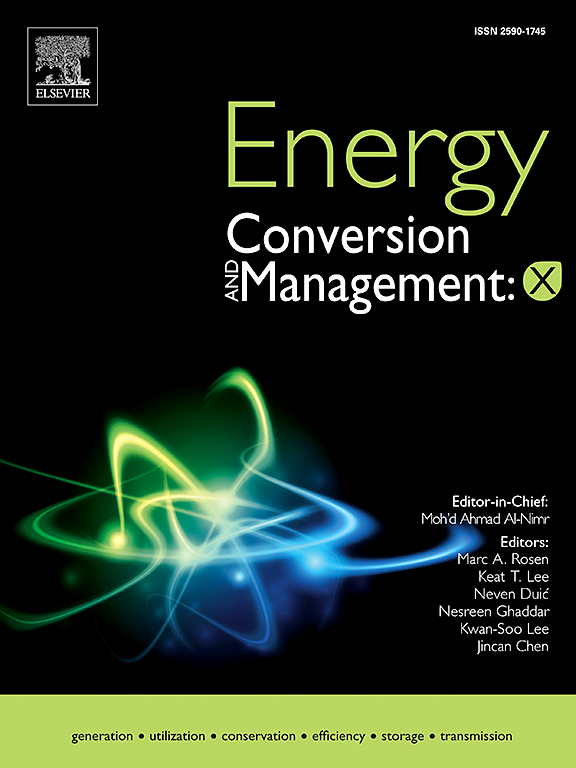A systemic study for decarbonizing secondary aluminium production via waste heat recovery, carbon management and renewable energy integration
IF 10.9
1区 工程技术
Q1 ENERGY & FUELS
引用次数: 0
Abstract
Secondary aluminium production relies on natural gas to transform both primary and recycled aluminium into semi-fabricated products, leading to significant atmospheric emissions, energy losses, and resource consumption. Despite the potential for waste heat recovery from stacks, casting water, and ancillary systems, wide-ranging temperature levels of waste heat produced complicate process integration. This work presents a systemic approach to enhance waste heat recovery, reduce fossil fuel consumption, integrate renewable energy resources, and use low-grade waste heat from a secondary aluminium plant to supply the heating requirements of a neighboring urban system. The goal is to highlight the role of process integration in decarbonizing and diversifying the industry’s energy requirements. A comprehensive techno-economic analysis evaluates decarbonization strategies, including, carbon capture, use, and sequestration; biomass energy conversion; oxycombustion furnaces; power-to-gas units; combined heat and power; heat pumps and seasonal storage units, considering energy prices, city demands, and seasonal variations. A systematic framework is employed to determine the most suitable decarbonization routes, while maintaining operational and financial feasibility. Results show that, carbon capture alone can only halve current CO2 emissions (to 100 kgCO2/tAl). Meanwhile integrated renewable electricity and biomass options achieve −200 kgCO2/tAl with 27% lower total energy and 40% less biomass use than biomass-only configurations. Power-to-gas systems without biomass import reduce emissions by only 80%, making them also unsuitable for net-zero targets. Finally, electricity self-generation of 30% of the overall power consumption can be achieved if the exothermic reaction enthalpy of carbon mineralization is recovered for various applications, such as biomass drying, steam generation, amine regeneration, and district heating. These findings highlight the need for a holistic approach that optimizes resource integration, minimizes emissions, and ensures long-term sustainability in secondary aluminium production.

通过余热回收、碳管理和可再生能源整合对二次铝生产脱碳的系统研究
二次铝生产依靠天然气将原铝和再生铝转化为半成品,导致大量的大气排放、能源损失和资源消耗。尽管有可能从烟囱、浇铸水和辅助系统中回收废热,但废热的广泛温度水平产生了复杂的工艺集成。这项工作提出了一种系统的方法来提高废热回收,减少化石燃料消耗,整合可再生能源资源,并利用二次铝厂的低品位废热来满足邻近城市系统的供暖需求。其目标是突出工艺整合在脱碳和多样化行业能源需求中的作用。综合技术经济分析评估脱碳战略,包括碳捕获、利用和封存;生物质能源转化;oxycombustion炉;power-to-gas单位;热电联产;热泵和季节性储存装置,考虑能源价格,城市需求和季节变化。采用系统框架来确定最合适的脱碳路线,同时保持业务和财务可行性。结果表明,单靠碳捕获只能将当前的二氧化碳排放量减半(降至100 kgCO2/tAl)。与此同时,综合可再生电力和生物质选择实现- 200 kgCO2/tAl,总能源比纯生物质配置低27%,生物质使用减少40%。没有生物质进口的电制气系统只能减少80%的排放,这使得它们也不适合实现净零排放目标。最后,如果回收碳矿化的放热反应焓,用于生物质干燥、蒸汽产生、胺再生和区域供热等各种应用,则可以实现总耗电量的30%的电力自产。这些发现强调需要一个整体的方法来优化资源整合,最大限度地减少排放,并确保二次铝生产的长期可持续性。
本文章由计算机程序翻译,如有差异,请以英文原文为准。
求助全文
约1分钟内获得全文
求助全文
来源期刊

Energy Conversion and Management
工程技术-力学
CiteScore
19.00
自引率
11.50%
发文量
1304
审稿时长
17 days
期刊介绍:
The journal Energy Conversion and Management provides a forum for publishing original contributions and comprehensive technical review articles of interdisciplinary and original research on all important energy topics.
The topics considered include energy generation, utilization, conversion, storage, transmission, conservation, management and sustainability. These topics typically involve various types of energy such as mechanical, thermal, nuclear, chemical, electromagnetic, magnetic and electric. These energy types cover all known energy resources, including renewable resources (e.g., solar, bio, hydro, wind, geothermal and ocean energy), fossil fuels and nuclear resources.
 求助内容:
求助内容: 应助结果提醒方式:
应助结果提醒方式:


